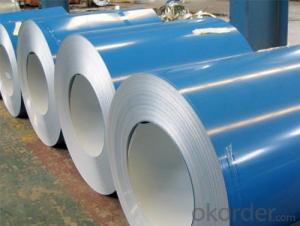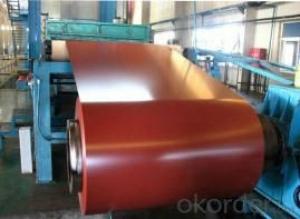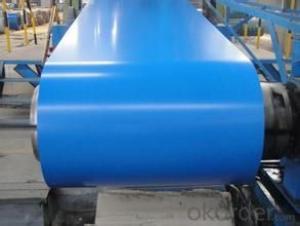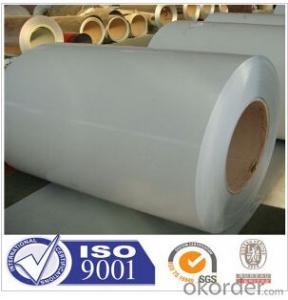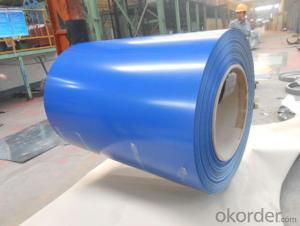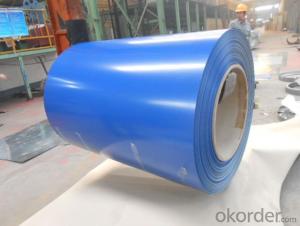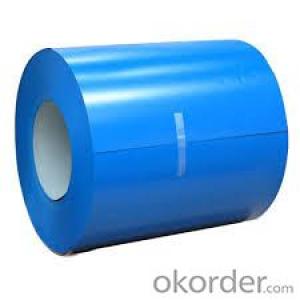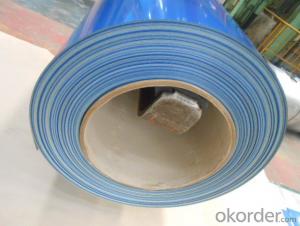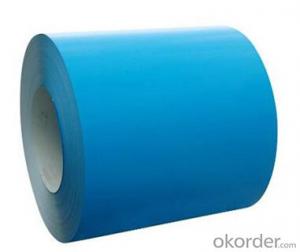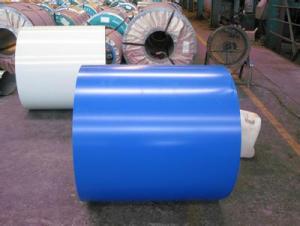Pre-Painted Galvanized Steel Sheet/Coil Prime Quality Blue Color
- Loading Port:
- Shanghai
- Payment Terms:
- TT OR LC
- Min Order Qty:
- 200 m.t.
- Supply Capability:
- 20000 m.t./month
OKorder Service Pledge
OKorder Financial Service
You Might Also Like
1.Structure of Pre-painted Galvanized/Aluzinc Steel Coil Description
With GI (aluzinc) as base metal, after pretreatment (degrease and chemical treatment) and liquid dope with several layers of color, then after firing and cooling, finally the plate steel is called pre-painted galvanized (aluzinc) steel. It generally displays workability, durability and weather resistance.
2.Main Features of the Pre-painted Galvanized/Aluzinc Steel Coil
• Excellent corrosion resistance
• Excellent weather resistance
• Excellent heat resistance performance
• High strength
• Good formability
• Good visual effect
3.Pre-painted Galvanized/Aluzinc Steel Coil Images
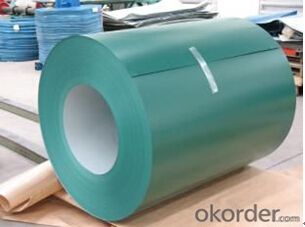
4.Pre-painted Galvanized/Aluzinc Steel Coil Specification
Quality standar: JIS G3312 CGCC & CGLCC
Hardness of P: Both soft and hard quality are available
Surface finish: with or without protect film
8Zinc coating: 60-275G/M2, both sides
Paint thickness for top side : 5 micron primer + (10-20) microns modified polyester, green color.
Paint thickness for back side: (5-10) microns Epoxy
Weight per coil: 4-6 tons, also can be upon customer's requirements
Thickness : 0.14-1.20 mm
Width : 914mm, 1000mm, 1220mm and 1250mm, thickness 600-1250mm is available
Finish by coil or sheet: Both sheet and coil are available
Max loading weight in one 20ft container : 25 tons generally
5. FAQ of Pre-painted Galvanized/Aluzinc Steel Coil
We have organized several common questions for our clients,may help you sincerely:
1. How long can we receive the product after purchase?
Usually within thirty working days after receiving buyer’s advance payment or LC. We will arrange the factory manufacturing as soon as possible. The cargo readiness usually takes 15-25 days, but the shipment will depend on the vessel situation.
- Q: How are steel coils used in the production of aerospace parts?
- Steel coils are widely used in the production of aerospace parts due to their strength, durability, and versatility. These coils are typically made from high-quality carbon steel and are formed into a coil shape for easy transport and storage. In the aerospace industry, steel coils are primarily used in the manufacturing of various components such as structural parts, engine parts, landing gear, and fasteners. One of the main applications of steel coils is in the fabrication of aircraft frames and fuselage structures. These coils are often cut, shaped, and welded to create the necessary structural components that provide strength and stability to the aircraft. Another important use of steel coils in aerospace production is in the manufacturing of engine parts. Steel coils are processed and formed into complex shapes to create components such as turbine blades, shafts, and casings. These components need to withstand high temperatures, pressure, and stress, and steel coils offer the necessary strength and heat resistance required for such demanding applications. Steel coils are also utilized in the production of landing gear, which is responsible for supporting the aircraft during takeoff, landing, and ground operations. The coils are processed and formed into various parts of the landing gear system, including struts, beams, and brackets. These parts undergo rigorous testing and need to possess excellent strength, toughness, and fatigue resistance, all of which are provided by steel coils. Furthermore, steel coils are commonly used for manufacturing fasteners in aerospace applications. Fasteners such as bolts, screws, and rivets play a crucial role in joining different components together, ensuring structural integrity and safety. Steel coils are processed and formed into the desired fastener shapes, providing the necessary strength and reliability for these critical connections. Overall, steel coils are essential in the production of aerospace parts due to their exceptional mechanical properties and reliability. Their versatility allows for various shaping and processing techniques, enabling the creation of complex and high-performance components. By utilizing steel coils in aerospace manufacturing, the industry can ensure the production of durable, safe, and efficient aircraft.
- Q: I noticed a friend's appliances are not magnetic, and mine are. Both are stainless steel. Are there two types of stainless steel or something? Thanks
- Is Stainless Steel Magnetic
- Q: Will a stainless steel mesh screen scratch a titanium cup, or vice versa?I have a titanium french press and am thinking about replacing the included press with an all steel one. I am worried about little flakes of titanium or steel getting ground off into the coffee when the press slides in and out. The original press has a polyester cloth for a screen, so nothing scratches.
- Steel is usually harder than titanium, at least when both materials are hear-treated to give their best strengths. And a harder material can scratch a softer one. So I imagine that the answer is that it will scratch. However much of the rest of your question is unclear and it may be that the amount of friction between the two is so small that no wear will take place, so there could be no problem. The function of the polyester cloth may be vital in reducing this friction, so that unless you keep this part of the original design, the scratching will become worse no matter which combination of metals are used.
- Q: What are the environmental considerations associated with steel coil production?
- The environmental considerations associated with steel coil production include the extraction of raw materials, such as iron ore and coal, which can lead to habitat destruction and air/water pollution. The manufacturing process involves energy-intensive operations and emissions of greenhouse gases, contributing to climate change. Waste generated during production, such as slag and dust, can also have negative impacts on the environment if not properly managed. Additionally, the transportation of steel coils over long distances can result in carbon emissions and increase the overall environmental footprint of the product.
- Q: Hi All,I was wanting to know,on the quality bikes such as Trek,Giant etc is the aluminum frames as strong as the steel frame bikes? I have heard conflicting reports on this,so thought I would ask here for more input.Thanks!
- Someone stated even the $99 walmart bikes are aluminum now. WRONG! Most Walmart bikes have steel frames unless you drop about $200.00. Personally, I prefer aluminum over steel. It's lighter, most times - just as strong and won't rust if you get a ding or scrape in the paint. See links below on Trek M/B. Trek 820 - steel frame - $329.99. Trek 3500 - aluminum frame - $359.99.
- Q: How are steel coils inspected for quality?
- Steel coils are inspected for quality through various methods such as visual inspection, dimensional measurement, and non-destructive testing techniques. These inspections ensure that the coils meet specific quality standards and requirements by examining their surface condition, dimensions, and internal integrity.
- Q: I know you can still but steel core ammo. I have read that it IS Armor Piercing (AP) and I have read it is not. Which is true? I am not looking for its AP capabilities. I want it if it is or is not AP. I live in Oklahoma. I need to know if it legal for me to purchase it in this state; and where can i get it? I am over 18, not a felon, etc. I have seen it sold online in Oklahoma years ago, but have read it is and isn't legal to purchase here. I am looking for 7.62x39 steel core for an SKS. If anyone knows where or how to get some, please let me know, if it's legal. Thanks.
- You can legally buy chinese steel core and 855 5.56 which is also steel core. That's on the federal level. I don't know about your state in particular but ammo peircing ammo is illegal but there are different grades of steel. If that were the case I couldn't buy Bugarian steel cased light ball in 7.62x54R.
- Q: What are the main factors that affect the strength of steel coils?
- The main factors that affect the strength of steel coils include the quality and composition of the steel used, the manufacturing process, the thickness and width of the coils, and any heat treatment or tempering applied to the steel. Additionally, factors such as storage conditions, handling, and transportation can also impact the strength of steel coils.
- Q: What are the different cutting methods for steel coils?
- Steel coils can be cut using various methods depending on specific requirements and desired outcomes. Some commonly used cutting methods for steel coils include: 1. Slitting: Narrower strips can be obtained by cutting the steel coil using a slitting machine equipped with multiple circular blades. The coil is unwound and passed through the blades, resulting in the desired width. Slitting is commonly employed in industries like automotive manufacturing or electrical appliance production, where narrower steel strips are needed. 2. Shearing: This method involves using a shear machine with a straight blade to cut through the steel coil. The blade presses against the coil, cutting it into desired lengths or shapes. Shearing is ideal for applications requiring precise cuts or specific sizes. 3. Laser cutting: A high-powered laser is used to cut through the steel coil in this advanced method. The laser beam is directed onto the coil, melting or vaporizing the metal to create a clean and accurate cut. Laser cutting is highly precise and can be used to cut intricate designs or patterns into the steel coil. It finds applications in industries such as aerospace, automotive, and electronics. 4. Plasma cutting: A high-velocity jet of ionized gas, usually a mixture of oxygen and an inert gas like nitrogen or argon, is employed to melt and remove metal from the steel coil. Plasma cutting is known for its speed and versatility, as it can cut through various metals, including steel. It is commonly used in industries like shipbuilding or construction, where fast and efficient cutting is required. These are just a few of the cutting methods available for steel coils. The choice of method depends on factors such as desired outcome, coil thickness, and specific application requirements. It is advisable to consult with a professional or specialist to determine the most suitable cutting method for your specific needs.
- Q: i want a good modern carbon steel (not stainless) knife. trying to keep it under 50$ also nothing to gruesome just a small pocket knife. thank you
- Well, okorder /... They did make other folders in M2 steel, but the thing is those are out of production and the cost is very high. Spyderco made M4 steel folder knives, and so did Benchmade. Although,both are outside of 50$ budget. I guess Opinels are best option.
Send your message to us
Pre-Painted Galvanized Steel Sheet/Coil Prime Quality Blue Color
- Loading Port:
- Shanghai
- Payment Terms:
- TT OR LC
- Min Order Qty:
- 200 m.t.
- Supply Capability:
- 20000 m.t./month
OKorder Service Pledge
OKorder Financial Service
Similar products
Hot products
Hot Searches
Related keywords
